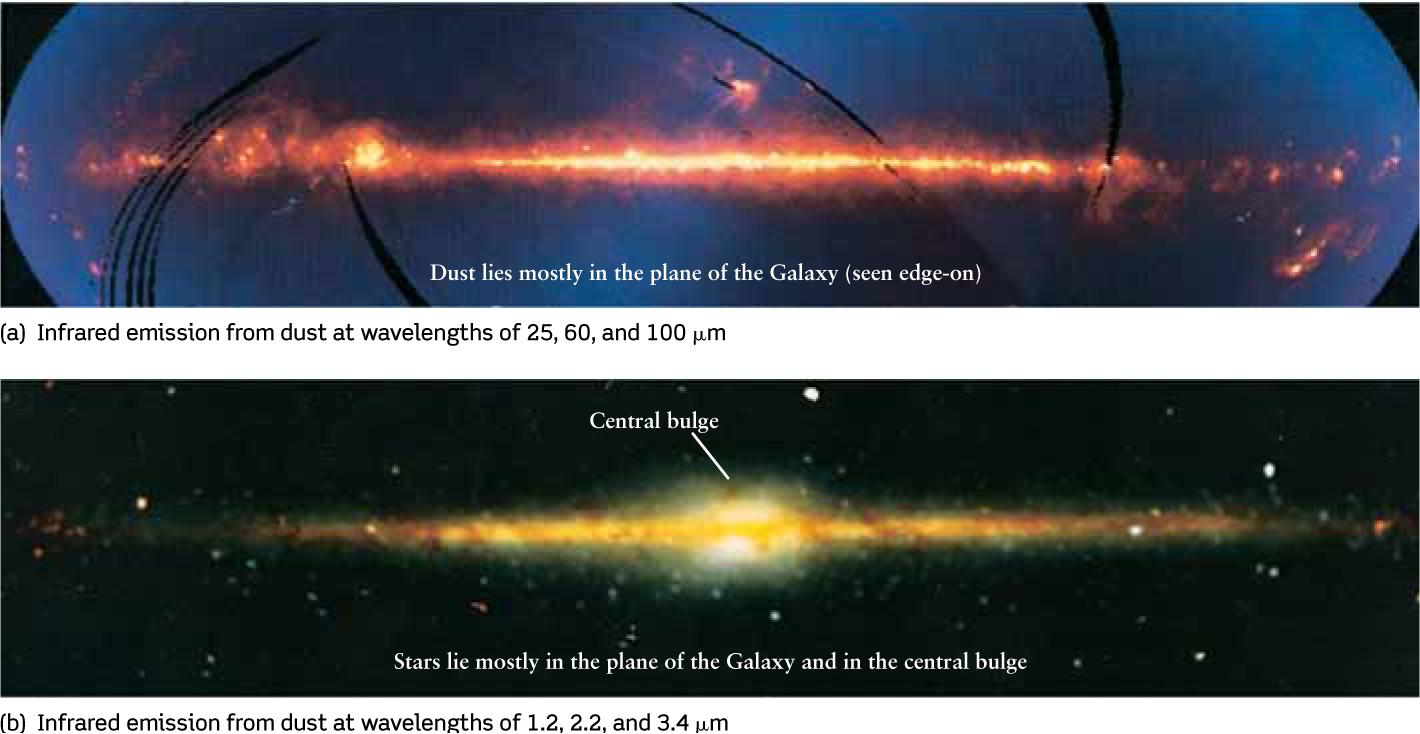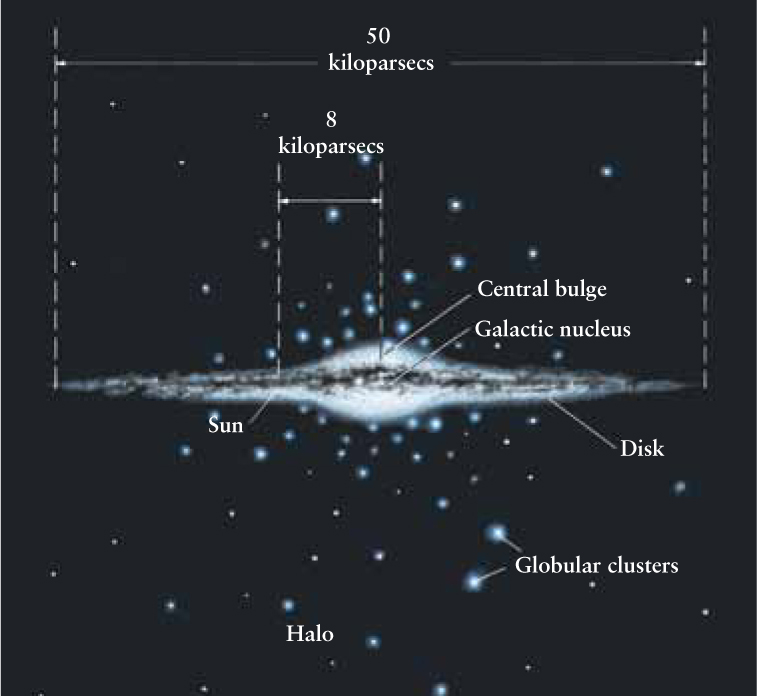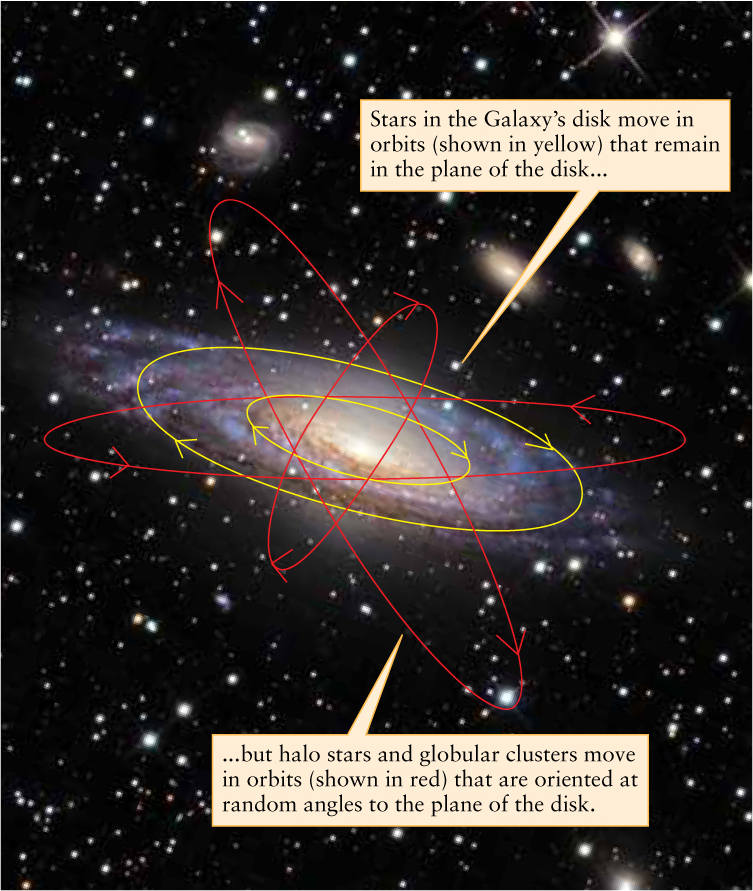22-2 Observations at nonvisible wavelengths reveal the shape of the Galaxy
At visible wavelengths, light suffers so much interstellar extinction that the center of the galaxy is totally obscured from view. But the amount of interstellar extinction is roughly inversely proportional to wavelength of light. In other words, the longer the wavelength of light, the farther that light can travel through interstellar dust without being scattered or absorbed. As a result, we can see farther into the plane of the Milky Way at infrared wavelengths than at visible wavelengths, and radio waves can travel all the way through the Galaxy! For this reason, telescopes sensitive to these nonvisible wavelengths are important tools for studying the structure of our Galaxy.
Exploring the Milky Way in the Infrared
Our Galaxy’s dust and stars—including the Sun—lie mostly in a relatively thin disk
Infrared light is particularly useful for tracing the location of interstellar dust in the Galaxy. Starlight warms the dust grains to temperatures in the range of 10 to 90 K; thus, in accordance with Wien’s law (see Section 5-4), the dust emits radiation predominately at wavelengths from about 30 to 300 μm. These are called far-infrared wavelengths, because they lie in the part of the infrared spectrum most different in wave-length from visible light (see Figure 5-7). At these wavelengths, interstellar dust radiates more strongly than stars, so a far-infrared view of the sky is principally a view of where the dust is. In 1983 the Infrared Astronomical Satellite (IRAS) scanned the sky with a 60-cm reflecting telescope at far-infrared wavelengths, giving the panoramic view of the Milky Way’s dust shown in Figure 22-6a.

The Infrared Milky Way (a) This view was constructed from observations made at far-infrared wavelengths by the IRAS spacecraft. Interstellar dust, which is mostly confined to the plane of the Galaxy, is the principal source of radiation in this wavelength range. (b) Observing at near-infrared wavelengths, as in this composite of COBE data, allows us to see much farther through interstellar dust than we can at visible wavelengths. Light in this wavelength range comes mostly from stars in the plane of the Galaxy and in the bulge at the Galaxy’s center.

In 1990 an instrument on the Cosmic Background Explorer (COBE) satellite scanned the sky at near-infrared wavelengths, that is, relatively short wavelengths closer to the visible spectrum. Figure 22-6b shows the resulting near-infrared view of the plane of the Milky Way. At near-infrared wavelengths, interstellar dust does not emit very much light. Hence, the light sources in Figure 22-6b are stars, which do emit strongly in the near-infrared (especially the cool stars, such as red giants and supergiants). Because interstellar dust causes little interstellar extinction in the near-infrared, many of the stars whose light is recorded in Figure 22-6b lie deep within the Milky Way.
Observations such as those shown in Figure 22-6, along with the known distance to the center of the Galaxy, have helped astronomers establish the dimensions of the Galaxy. The disk of our Galaxy is about 50 kpc (160,000 ly) in diameter and about 0.6 kpc (2000 ly) thick, as shown in Figure 22-7. The center of the Galaxy is surrounded by a distribution of stars, called the central bulge, which is about 2 kpc (6500 ly) in diameter. This central bulge is clearly visible in Figure 22-6b. The spherical distribution of globular clusters traces the halo of the Galaxy.
This structure is not unique to our Milky Way Galaxy. Figure 22-8 shows another galaxy whose dust and stars lie in a disk and that has a central bulge of stars, just like the Milky Way. In the same way that our Sun is a rather ordinary member of the stellar community that makes up the Milky Way, the Milky Way turns out to be a rather common variety of galaxy.

NGC 7331: A Near-Twin of the Milky Way If we could view our Galaxy from a great distance, it would probably look like this galaxy in the constellation Pegasus. As in Figure 22-6, the far-infrared image (a) reveals the presence of dust in the galaxy’s plane, while the near-infrared image (b) shows the distribution of stars. These images of NGC 7331, which is about 15 million pc (50 million ly) from Earth, were made with the Spitzer Space Telescope (see Section 6-7, especially Figure 6-26).
CONCEPT CHECK 22-2
If an astronomer wanted to study the nature of cool stars hiding inside dust clouds, which wavelength would be the best choice, near-infrared (with shorter wavelengths that are nearer to the visible spectrum) or far-infrared (with longer wavelengths farther from the visible spectrum)?
Far-infrared wavelengths best reveal the presence of warmed dust grains, and weak emission from stars is not easily detected with dust around. Near-infrared wavelengths, which can pass through dust, are emitted more strongly from cool stars than far-infrared, making near-infrared a better choice.
CONCEPT CHECK 22-3
Would an imaginary space traveler have a better view of our Sun and its planets by standing at the galactic center or in the halo?
As the view between the galactic center and the Sun is obscured by intervening dust, the better vantage point would be from outside the disk in the halo, where the path of light is largely unobstructed by dust.
The Milky Way’s Distinct Stellar Populations

Star Orbits in the Milky Way The different populations of stars in our Galaxy travel along different sorts of orbits. The galaxy in this visible-light image is the Milky Way’s near-twin NGC 7331, the same galaxy shown at infrared wavelengths in Figure 22-8.
It is estimated that our Galaxy contains about 200 billion (2 × 1011) stars. Remarkably, different kinds of stars are found in the various components of the Galaxy. The globular clusters in the halo are composed of old, metal-poor, Population II stars (see Section 19-5). Although globular clusters are conspicuous, they contain only about 1% of the total number of stars in the halo; most halo stars are single Population II stars in isolation. These ancient stars orbit the Galaxy along paths tilted at random angles to the disk of the Milky Way, as do the globular clusters. By contrast, stars in the disk travel along orbits that remain in the disk (Figure 22-9).
Unlike the halo, the stars in the disk are mostly young, metal-rich, Population I stars like the Sun. The disk of a galaxy like the Milky Way appears bluish because its light is dominated by radiation from hot O and B main-sequence stars. Such stars have very short main-sequence lifetimes (see Section 19-1, especially Table 19-1), so they must be quite young by astronomical standards. Hence, their presence shows that there must be active star formation in the galactic disk. By contrast, no O or B stars are present in the halo, which implies that star formation ceased there long ago.
The central bulge contains both Population I stars and metal-poor Population II stars. Since Population II stars are thought to have formed early in the history of the universe, this suggests that some of the stars in the bulge are quite ancient while others were created more recently. The central bulge looks yellowish or reddish because it contains many red giants and red supergiants (see Figure 1-7), but does not contain luminous, short-lived, blue O or B stars. Hence, there cannot be ongoing star formation in the central bulge. The same is true for other galaxies whose structure is similar to that of the Milky Way (Figure 22-10).
Why are there such different populations of stars in the halo, disk, and central bulge? Why has star formation stopped in some regions of the Galaxy but continues in other regions? The answers to these questions are related to the way that stars, as well as the gas and dust from which stars form, move within the Galaxy.

Stellar Populations: Disk Versus Central Bulge The disk and central bulge of the Milky Way contain rather different populations of stars. The same is true for the galaxy NGC 1309, which has a similar structure to the Milky Way Galaxy and happens to be oriented face-on to us. NGC 1309 is about 30 million pc (100 million ly) from us in the constellation Eridanus.
CONCEPT CHECK 22-4
If you were looking to find the most recently formed stars in the Galaxy, where would you most likely look?
There is virtually no star formation occurring in the surrounding halo, so the youngest stars would be found actively forming in the rich dusty regions along the Galaxy’s disk.